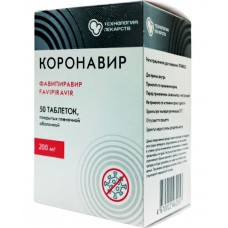Expiration date: 01/2024
Instructions for children and pregnant women
In preclinical studies of favipiravir at dosages similar to clinical or lower, early embryo death and teratogenicity were observed.
Coronavir the drug is contraindicated in pregnant and women and men during pregnancy planning. When prescribing the drug CORONAVIR to women who are capable of childbearing (including postmenopausal women less than 2 years old), it is necessary to confirm a negative pregnancy test result before starting treatment. A second pregnancy test should be performed after the end of taking the drug. It is necessary to use effective methods of contraception (a condom with spermicide) during and after taking the drug: for 1 month for women and for 3 months for men.
When prescribing the drug CORONAVIR, nursing women should stop breastfeeding while taking the drug and within 7 days after it ends, since the main metabolite of favipiravir enters breast milk.
Pharmacotherapeutic group: antiviral agent
Pharmacological properties
Pharmacodynamics
Antiviral activity in vitro
Favipiravir has antiviral activity against laboratory strains of influenza A and B viruses (half maximum effective concentration (EC50) 0.014-0.55 mcg/ml).
For strains of influenza A and B viruses that are resistant to adamantane (amantadine and rimantadine), oseltamivir or zanamivir, the EC50 is 0.03-0.94 mcg/ml and 0.09-0.83 mcg/ml, respectively. For influenza A virus strains (including strains resistant to adamantane, oseltamivir, and zanamivir), such as swine flu type A and avian flu type A, including highly pathogenic strains (including H5N1 and H7N9), the EC50 is 0.06-3.53 mcg/ml.
For strains of influenza A and B viruses resistant to adamantane, oseltamivir and zanamivir, the EC50 is 0.09-0.47 mcg/ml; cross-resistance is not observed.
Favipiravir inhibits the SARS-CoV-2 virus, which causes a new coronavirus infection (COVID-19). The EC50 in Vero E6 cells is 61.88 mmol, which corresponds to 9.72 mcg/ml.
Mechanism of action
Favipiravir is metabolized in cells to favipiravir ribosyl triphosphate (favipiravir RTF) and selectively inhibits RNA-dependent RNA polymerase involved in influenza virus replication. The RTF of favipiravir (1000 mmol/l) did not show an inhibitory effect on a human DNA, but showed an inhibitory effect in the range of 9.1 to 13.5 % on ? and in the range of 11.7 to 41.2 % on ? human DNA. The inhibitory concentration (IC50) of RTF favipiravir for human RNA polymerase II was 905 mmol/l.
Resistance
After 30 replants in the presence of favipiravir, there were no changes in the susceptibility of influenza A viruses to favipiravir, and no resistant strains were observed. In the conducted clinical studies, the appearance of influenza viruses resistant to favipiravir was not detected.
Pharmacokinetics
Absorption
favipiravir
is easily Absorbed in the gastrointestinal tract. Time to reach the maximum concentration (Tmax) – 1.5 hours.
The distribution
Of binding to plasma proteins is about 54 %.
Metabolism
Favipiravir is mainly metabolized by aldehyde oxidase and partially metabolized to the hydroxylated form by xanthine oxidase. Favipiravir RTF is metabolized in cells. In addition to hydroxylate, glucuronate conjugate was also recorded in human plasma and urine from other metabolites.
Breeding
Basically, favipiravir is excreted by the kidneys as an active metabolite of hydroxylate, a small amount – in unchanged form. The half – life (T1/2) is about 5 hours.
Patients with impaired liver function
When taking favipiravir in patients with mild to moderate hepatic insufficiency (classes A and B according to the child-Pugh classification), the increase in Cmax and AUC was 1.5 and 1.8 times, respectively, compared with healthy volunteers. These increases in Cmax and AUC for patients with severe hepatic insufficiency (class C according to the child-Pugh classification) were 2.1 and 6.3 times, respectively.
Patients with impaired renal function
In patients with moderate renal insufficiency (GFR <60 ml/min and ?30 ml/min), the residual concentration of favipiravir (Ctrough) increased by 1.5 times compared to patients without impaired renal function. The drug has not been studied in patients with severe and terminal renal insufficiency (GFR <30 ml/min).
Release form and composition
One film – coated tablet contains:
active substance: favipiravir- 200.0 mg.
Excipients: microcrystalline cellulose 101, colloidal silicon dioxide, povidone-K25, crospovidone, sodium stearyl fumarate.
Film shell: Opadray II 85F220031 yellow [polyvinyl alcohol, titanium dioxide, macrogol 4000, talc, iron oxide yellow dye].
Interaction
The drug CORONAVIR is not metabolized by cytochrome P450, mainly metabolized by aldehyde oxidase and partially metabolized by xanthine oxidase. The drug CORONAVIR inhibits aldehyde oxidase and cytochrome CYP2C8, but does not induce cytochrome P450.
How to take, course of administration and dosage
Inside, 30 minutes before meals.
For the treatment of a new coronavirus infection caused by the SARS-CoV-2 virus (COVID-19), the following dosage regimen is used: 1800 mg 2 times a day on the 1st day of therapy, then 800 mg 2 times a day from the 2nd to the 10th day of therapy.
The total duration of the course of treatment is 10 days or until confirmation of virus elimination, if it occurs earlier (2 consecutive negative PCR results obtained at intervals of at least 24 hours).
Contraindications
Hypersensitivity to favipiravir or any component of the drug Coronavir.
Severe hepatic insufficiency (class C according to the child-Pugh classification).
Severe and terminal renal failure (GFR <30 ml/min).
Pregnancy or pregnancy planning.
Breast-feeding period.
Children under 18 years of age.
With caution
In patients with a history of gout and hyperuricemia (possible increase in uric acid levels in the blood and exacerbation of symptoms), in elderly patients with mild to moderate hepatic insufficiency (child-Pugh class A and B), in patients with moderate renal insufficiency (GFR <60 ml/min and ?30 ml/min).
Special instruction
If a side effect develops, it is necessary to report it in accordance with the established procedure for the implementation of pharmacovigilance measures.
Before taking the drug CORONAVIR, the patient must provide written information about the effectiveness of the drug and the risks associated with its use (including the risk of affecting the embryo and fetus), and obtain written consent to use the drug.
Since animal studies of favipiravir have shown embryo death and teratogenicity, the drug CORONAVIR should not be prescribed to pregnant and presumably pregnant women.
When prescribing the drug CORONAVIR to women who are capable of childbearing (including postmenopausal women less than 2 years old), it is necessary to confirm a negative pregnancy test result before starting treatment. Women who are capable of childbearing should be fully explained the risks and carefully instructed to use the most effective methods of contraception with their partners while taking the drug and for 1 month after it ends (a condom with spermicide). If you assume that pregnancy may occur, you should immediately stop taking the drug and consult your doctor.
The distribution in the human body drug Coronavir gets to cum. When prescribing the drug, male patients should be fully explained the risks and carefully instructed to use the most effective methods of contraception during sexual contact during the drug intake and for 3 months after its end (a condom with spermicide). Additionally, male patients should be instructed not to have sexual contact with pregnant women.
The distribution in the human body drug Coronavir passes into breast milk. When prescribing the drug, nursing women should fully explain the risks and carefully instruct them to stop breastfeeding while taking the drug and within 7 days after it ends.
Influence on the ability to drive vehicles, mechanisms
Care should be taken when driving vehicles and working with mechanisms.
Coronavir indications for use
Treatment of a new coronavirus infection (COVID-19).
Side effects
In a clinical study of the drug Coronavir adverse reactions were observed in 29 patients out of 37 (78.4 per cent), including: hyperuricemia (in 23 patients (62,2 %)), increased ALT (8 patients (21,6 %)), raising the ACT (in 6 patients (16,2%)), diarrhea (7 patients (18,9 %)), elevation of creatine kinase (in 5 patients (13,5 %)), hyperglycemia (4 patients (10,8 %)), nausea (2 patients (5,4 %)), epigastric pain (2 patients (5,4 %)), increased LDH (in 1 patient (2,7 %)), increased ferritin levels (in 1 patient (2,7 %)), skin rash (in 2 patients (5,4 %)), increased sweating of the feet (in 1 patient (2.7 %)), chilly feet (in 1 patient (2.7 %)), headache (in 1 patient (2.7 %)), weakness in the hand (in 1 patient (2.7 %)), hematuria (in 1 patient (2.7%)).
Adverse reactions observed in clinical trials in patients with influenza infection (data from the analysis in the total population combined for safety assessment) are presented in table 1.
The estimation of the frequency of undesirable adverse reactions is based on the who classification: very common (?1/10); common (?1/100, <1/10); infrequent (?1/1000, <1/100); rare (?1/10 000, <1/1000); very rare (<1/10000); frequency unknown (it is not possible to determine the frequency from the available data).


